In the department of get it while you can, you might want to get a ’24 Toyota 4Runner with a V6 – and without a turbocharged four – while you still can.
Toyota has already dropped the V6 you used to be able to get in the Tacoma – which is the mid-sized pickup that the 4Runner shares its platform with. The just-updated ’24 Taco comes only with a turbocharged four now.
It is likely that the ’25 4Runner will follow suit next year, when it gets an update based on the just-updated Taco.
So if you’d like a 4Runner with a V6 – and without some of the other things that come standard in newer things – this year will likely be your last chance to get it.
The 4Runner is a mid-sized, five-door SUV that (cue the Sympathy for the Devil by the Rolling Stones) has been around for a long, long time. Fourteen years long, largely unchanged. Largely because change hasn’t been necessary. Because the 4Runner as it still is has never had any trouble selling – probably because it hasn’t changed much for the past 14 years.
People like that.
Unfortunately, the government doesn’t. That’s why the Tacoma has changed – from a truck you used top he able to get with a V6 (and with a manual transmission) to a turbo-four-only-powered truck that stickers for $31,500 to start. The turbo four in the new Taco offers slightly better gas mileage than the V6 it used to share in common with the 4Runner but what really matters (and explains the replacement) is that the turbo four’s “emissions” – of carbon dioxide, that gas that doesn’t have anything to do with pollution – are lower by dint of the engine being smaller.
If you still want the V6, it’s still standard in the current 4Runner, which lists for $40,705 to start for the base SR5 trim with 2WD; 4WD is available as a stand-alone option that brings the MSRP up to $42,580.
There are also TRD Sport ($43,565), SR5 Premium ($43,765), TRD Off-Road ($44,550), TRD Off-Road Premium ($47,130), Limited ($49,940) and top-of-the-line TRD Pro ($55,170) trims. All come standard with skid plates and 5,000 lbs. of standard towing capacity.
The TRD Sport gets 20-inch wheels, a hood scoop and firmer suspension tuning.
TRD trims come standard with 4WD as well as a locking rear differential and additional driver-selectable modes for off-road driving. TRD Pro trims add a lifted suspension with Fox off-road shocks, all-terrain tires and a TRD exhaust system.
All trims come standard with seating for five but you can get a third row and seven passenger seating optionally.
What’s New for 2024
There are no changes for what will likely be the final year for the 4Runner in its current form.
What’s Good
Standard V6 doesn’t need a turbo to make 270 horsepower.
14 year track record of reliability.
Holds value (see above).
What’s Not So Good
Last call means a rush to get what will soon be gone – and less likelihood of a haggled-down price for just that reason.
All trims come standard with “advanced driver assistance technology” – which drivers who don’t need “assistance” may not wish to pay for or be pestered by.
No optional V8 in the higher trims (the Lexus version of the 4Runner, the GX460, came standard with one).
The 4Runner comes standard with a 4.0 liter V6 that makes 270 horsepower, paired with a five speed automatic and rear-drive or (optionally) a part-time 4WD system with a two speed transfer case and 4WD Low range gearing.
Back in 2010, the 4Runner’s mechanicals – in general terms – were pretty common in mid-sized SUVs and pick-ups. Fast-forward 14 years and they are now exceptional – in the literal sense. In that the 4Runner is one of a dwindling number of new, mid-sized SUVs that still comes standard with a V6 (and body-on-frame construction).
The five speed automatic – with just one overdrive – is also a relic from the Before Time, when the main purpose of overdrive was to reduce engine RPM at highway speeds enough to make driving at highway speeds comfortable.
You may have noticed that almost all new vehicles come with automatic transmissions that have two (or more) overdrives and 7-10 speeds, all told. The reason for all those overdrives (plural) is to squeeze out minor mileage gains at all speeds.
To get some sense of this, consider the V6 4Runner’s 16 MPG in city driving and 19 on the highway. That’s not terrible for a 4,400 lb. body-on-frame 4WD SUV with a 270 horsepower V6. Now consider the 18-23 MPG achieved by the just-redesigned 2024 Taco, which comes only with a 2.4 liter turbocharged four cylinder engine and an eight speed automatic. That’s three more gears – and two fewer cylinders – and nearly the same mileage.
But the difference that matters is the lesser “emissions” – of the dread (inert) gas, carbon dioxide, that doesn’t have anything to do with air pollution. The little four “emits” less plant food when the engine’s just idling (and so not under boost) and when the Taco’s just cruising – and not much boost is needed to keep the Taco moving.
And that is how Toyota complies with the regs pertaining to “emissions”- which the public has been deceived into equating with the gasses that do cause pollution. These latter have been all-but-eliminated – thirty years ago – so the definition of “emissions” had to be expanded, in order to maintain the justification for “regulating” these “emissions.”
Bureaucrats have to eat too, doncha know.
But we’re all paying for that – in the form of smaller engines that need turbos to maintain the output of the larger engines being forced off the market. These smaller, turbocharged engines cost more (take a look at the new Taco’s base price vs. what the base price was last year) to buy and to maintain, because they’re more complicated, have more parts and are under a lot more pressure (literally) to produce the same power as the larger, simpler, less-stressed engines they’re replacing.
Just so you know.
The current 4Runner has been on the road a long time. Fourteen years. That is more than long enough for this SUV to have established a lengthy track record for durability. One nicely complemented by its capability.
This is a real SUV – not one that looks the part. The 4Runner has a full perimeter frame, so it’s very hard to hurt this one. If you dent a panel, it’s cosmetic – and it’s also usually easier to fix because when you are dealing with a body-on-frame SUV, most of the body panels bolt on (and off) and are not structural parts of the vehicle. Rusted fender? Remove it and replace it with one that’s not.
Hand tools only.
Some – who don’t know better and aren’t people who’d buy a 4Runner anyhow – criticize this SUV for driving like one. As if that were a bad thing. As if people who buy 4Runners were shopping for Camrys.
They’re not.
What you’re getting when you buy a 4Runner is kind of like you used to get when you bought an old muscle car such as my ’70s-era Pontiac Trans-Am. It has a “firm” ride, too. And that’s what people who bought ’em wanted – along with the big V8, the shaker hood scoop and the screaming chicken decal on the hood. To criticize the Trans-Am for having those attributes would be like criticizing Angelina Jolie (when she was still hot) for her attributes.
Or the 4Runner, for the same essential reason.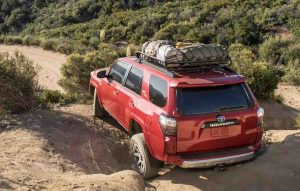
It is still wonderfully mechanical in a way that the new stuff no longer is. You feel more in direct control because you are. There’s a gear selector lever – not a button or a rotary knob controller. For the 4WD drive, too. Put your hand on it and you’ll be able to feel the connection – literally – to the drivetrain.
The V6 sounds right, too. In part because it sounds like something rather than nothing. Silence is the sound of the grave. This sound lets you know you’re still alive.
And the five speed transmission doesn’t shift too much – or too often. It has the right number of gears. Not too many gears.
Is it 4Runner quickest thing going? No. But it’ll still be going 14 years from now – and with probably another 14 left, after that. There is a reason why the 4Runner (and older Tacos) are so popular in parts of the world that are less developed. It is that they just keep going – and even when they sometimes need something, it’s usually something that can be fixed without a “software update” or a trip to the dealer for “programming.”
Because these SUVs were made before they began turning vehicles into devices.
The 4Runner is one of the smaller vehicles in the class – once again because it is the oldest vehicle in the class and so was made before the super-sizing of SUVs (and the trucks they’re based on) got going.
This is by no means a bad thing.
At 190.2 inches long, the 4Runner is about two inches shorter overall than a Camry sedan – and about eight inches shorter, bumper-to-bumper, than the Nissan Pathfinder, which looks like an SUV but is in fact a FWD-based crossover.
So the 4Runner will fit in a Camry-sized parking spot.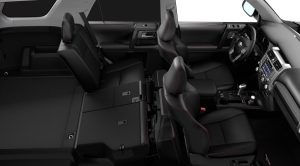
Room for five is standard but you can upgrade to seven by opting for the available third row. This gives you seven-passenger capability in a Camry-sized SUV that can also pull a Camry.
It also doesn’t look like it’s trying to squeeze something out of its tailpipe – as many of the newer SUVs do.
You may welcome the absence of a huge LCD touchscreen – which SUVs made 14 years ago didn’t have and neither does this one.
Next year, it almost certainly will.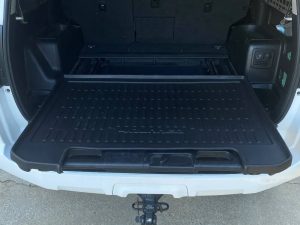
Same goes for the key you insert in the ignition lock to start the engine – as opposed to pushing a button. Much harder to hurt a cut key than an electronic fob. You can get a new key cut at any hardware store, too.
If you want the fob and push-button start, it’s available.
You can also get some unique features such as the optional sliding rear cargo deck, which can serve as a worktable or just a place to sit while tailgating. It supports 440 pounds, the weight of two large adults. In addition to that, there’s an available integrated 40 quart beverage chiller and a locking console safe (a great place to keep your pistol).
And these options are available in the base SR trim. You do not have to move up to the more expensive trims in order to be able to order them.
The Rest
While there is a touchscreen, there are also still knobs for most of the everyday things such as adjusting the temperature/fan speed as well as tuning the stereo system. This means you make those adjustments while driving without taking your attention off your driving.
And that’s why the 4Runner doesn’t need “advanced driver assistance technologies,” to correct for the dangers created by smartphone-emulating touchscreen-only controls.
The Bottom Line
The main detraction here is the cost. At just over $40k to start (and just under $43k with 4WD) the 4Runner isn’t inexpensive.
But then, priceless things often aren’t.
. . .
If you like what you’ve found here please consider supporting EPautos.
We depend on you to keep the wheels turning!
Our donate button is here.
If you prefer not to use PayPal, our mailing address is:
EPautos
721 Hummingbird Lane SE
Copper Hill, VA 24079
PS: Get an EPautos magnet or sticker or coaster in return for a $20 or more one-time donation or a $10 or more monthly recurring donation. (Please be sure to tell us you want a magnet or sticker or coaster – and also, provide an address, so we know where to mail the thing!)
If you like items like the Keeeeeeev T shirt pictured below, you can find that and more at the EPautos store!



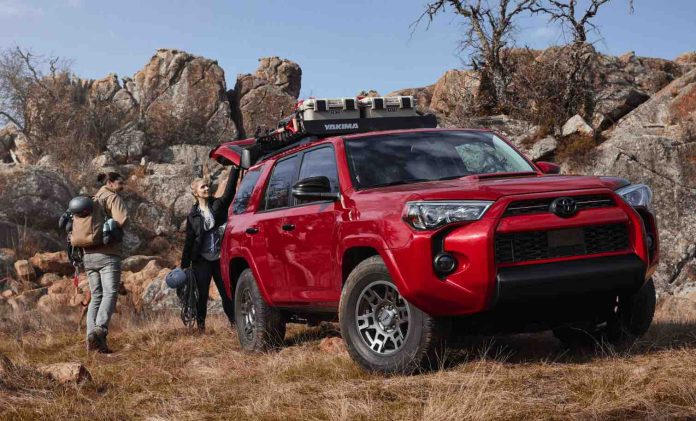


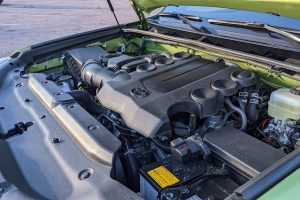
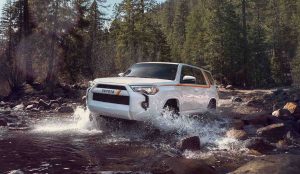









I won’t buy another 4 cylinder car. Period. So, Whatever is still available in 6 by the time I buy again is what it is.
I won’t even look. It makes car shopping a lot easier when you can eliminate 90% of them.
Makes me want to get a 1000 hp Trail Hawk that I don’t really want or need, just because.
Hi Matt,
I have no issue with four cylinder engines where they are appropriate, as in economy cars and small cars and sports cars. But it is ridiculous to use a four to power a full-sized truck or family-sized crossover. Why? Because it requires adding a turbo (or two) and all the peripherals, to boost the output to a level sufficient to move the vehicle adequately. This increases cost and reduces reliability/longevity. Well, why not just a V6 instead? It’s simpler and under less pressure – and the mileage difference is negligible in real-world driving. The only reason fours are being used in these applications is because of regulatory compliance pressure.
You were correct, Eric:
https://www.caranddriver.com/news/a60441721/2025-toyota-4runner-revealed/
Hi Yeti,
Yup. And here I note C&D’s effusive amen’ing of the gelding. No mention of why the V6 is gone. No discussion of the jacked-up price of the new turbo-four-hybrid and the almost certain long-term durability decline that will attend. Just good news, comrades! The chocolate ration has been increased to 10 gramms from 5!
What is with the ugly ass IPad?!?! A long time ago car manufacturers actually cared how a car was styled – the lines, the functions, etc. Not anymore…just throw a huge computer screen up on the dash…if it blocks the visibility of the windshield…oh, well.
Morning, RG!
Sadly, they’re all like this now. You cannot escape the iPod in the dash. Except by not buying anything new.
And this is why I will not buy anything made after 2014.
Ditto!
I won’t go newer than 2002, myself. I’m very interested in a ’90s-era JDM Toyota HiLux surf with the diesel engine. The perfect SUV/pick-up, in my opinion. There’s a reason the Jihadis love them!
This just blew my mind:
https://bringatrailer.com/listing/2000-toyota-4runner-75/
$40K! I guess there are people out there who agree with you!
The first 2 lines say it all:
“2025 Toyota 4Runner Is Finally Here and Appears Worth the Wait
The fifth-generation off-road SUV had a successful 15-year run, but the sixth-gen’s new powertrains and upgraded frame make it easy to move on.”
Wow! As if 4Runner fans have been dying to get a more expensive, and potentially LESS RELIABLE off-roader! I also love how C&D has the gall to say “powertrains”, ’cause apparently, ONE engine with like 20 different HP ratings now counts as 20 separate “engines”. Welp, looks like even Toyota couldn’t escape the long arm of the UN/WEF/etc.
Car and Driver is a joke though
All I can say is, thank God I got my 3rd-gen “Taco” when I did, albeit barely. Wanted to get it in silver, but was a wee bit too late for the base 4-door model, so had to settle for white instead. Was holding out on getting a new vehicle for as long as I could, but then reality happened. My TrailBlazer began spending more time in the shop than on the road, and there’s only so much DIY one can do when living in an apartment. So far, a great no-nonsense pickup that’s relatively affordable, and probably the last of its kind here in ‘Murica. Of course, it’s got ADAT, but thankfully, it’s pretty basic AND it can be disabled (for now).
Love my MY 2021 4Runner. Of course when I bought mine (Venture Edition- pretty much a TRD Off Road Premium) the msrp was $44,620 and that is with a financing rate in the 2’s for 72 months. Also got the $750 Keep it Wild Savings. Today you’d be more likely to have a dealer markup. Same vehicle today would cost probably 5k more on its face and then hundreds more in interest per month. Even though the 4Runner is a different application than the Tacoma for sure, many people, including myself, do consider both. I went with 4Runner because of Japan-built, same Tahara factory as Lexus GX and LX. Legendary build quality. Also, the 1GR-FE motor is reputed to be better. An added plus for tax purposes is that its GVWR is just over 6,000. Tacoma is not. Probably one of the only Toyotas left with not only a physical key but real gauges.
Wait, there’s a new 4Runner with an actual key?! Funny, I was thinking about getting one, but the cheapest one is like $50K in my area.
And this, is one of the many reasons Eric’s reviews are so good: “a locking console safe (a great place to keep your pistol).”
Wish my FJ had one. It’s been on my Mods-to-do list for a very long time.
We test drove the 4-Runner when we were looking in 2007, the only thing which bumped it off the list in favor of the FJ was elbow room. We were replacing an aging S-10 Blazer (boy do I miss that one, the Vortex 4.3) anyway, our elbows often bumped in the S-10, gets kind of annoying after awhile, the 4-Runner was the same experience. …Still, if I couldn’t have an FJ (and esp after reading about the other features in this review) the 4-Runner would be top pick. …If only I could have a bigger stable.
‘one of the many reasons Eric’s reviews are so good: “a locking console safe (a great place to keep your pistol).”’ — helot
Jalopnik version: “a locking console safe (a great place to keep your man-purse, mascara and covid mask).”
Ha! …No doubt.
Aftermarket safes exist for the FJ, just search the interwebz. I have a couple on my “want list” for my Taco.
Thanks, Helot!
It’s fun to review vehicles like the 4Runner; it’s less fun to try to come up with anything worth saying about a device.
So here is a question for you. And you may not (with reviewing vehicles) be able to say. But…what was the worst car review you ever had to write? Just curious…
Hi Shadow,
That’s easy. Every single EeeeeeeeeeeeeeVeeeeeeee. Chiefly because I could barely drive them anywhere. The Benz EQS I drove last December was barely able to go into town and back when it was cold; forget making it out to visit my mom 50 miles distant (and back). I wrote about that. Now I’m off the Benz press car list!
…and was that with the heater running or did you have to freeze your balls off to eek out every last bit of range? Well, maybe if EVs were better they wouldn’t have such lousy reviews.
I looked at the 4Runner before I got the F-150. I was astonished at the prices of the used ones. Almost no reason not to buy new. I have no need for a full size pickup any longer and the 4Runner and Taco are on my short list. Thanks for the review!
You bet, Yeti!
A Taco is on my list as well; actually, a Hi-Lux diesel/4WD/manual. I’m just waiting for the moment…
With or without the machine gun mounted in the bed?
They show up on BaT on occasion. This one was an auto, but the crane is freaking cool.
https://bringatrailer.com/listing/1995-toyota-hilux-ssr-x-turbodiesel-4×4/
As I mentioned before, I had one as a rental for a destination wedding in Sedona 2 years ago. Up until then, I never got the appeal, but driving it around town was nice, felt like a real suv/truck, took regular and was simplistic as hell.
Wish I found trails, did go offroading slightly as I drove through the red rocks to pick up the bride and groom as it poured during their wedding, got everyone too and from. I’m a dye in the wool #SaveTheManuals guy, but this gets a pass in my books.
Only thing I’d have done different was actively find a trail, and maybe have traveled a bit more, although it felt so OG, and I went everywhere with that brute.
Again, I drive manuals, but I’d love to have one in the future. Only saving grace about the updated model is it’s said to come with Manual and still be built in Japan, but then, if I had the $$$, I’d find one that a cheap one that’s solid but high in miles and do this instead: https://www.dieseltoys.com/4runner
The Sedona city roads are paved (and hellishly congested.) If you want off-road trails, just park outside the Pink Jeep Tours facility. Follow one of their outbound tour jeeps, and you’ll find trails that are “just right” for something like a 4 Runner.
Next time around, although when I went to get the bride and groom, they pink jeeps were looking at me like “O.o”.
I’ll be back, so much of Az I wanna explore, loved the arid nature of the state, just need to find more down to earth area that feels more home town than destination central.
I really liked my 05 4runner.
Sure it felt heavy and wasn’t the fastest thing, but was a great snow vehicle and capable on the mountain dirt roads.
And I’ll give a thumbs up to the Michelin XCX’s I had on it. Best all around tire until they hit 5 years old and turn into rocks that slide in the snow.
Neighbor has a ’23 Sequoia. The exhaust sounds like it has a leak. Turns out that it’s stock & it just sounds like that. Too loud IMHO. Otherwise it’s a nice albeit very expensive ride.
That the V8 or V6 model? No 4runner v6 ever sounds good, that’s a fact
It takes around $50 K to purchase a new vehicle that’s desirable these days and with that in mind, a 4-Runner would be considered a bargain for what you get. Simplicity and long term durability is getting hard to find new these days.
No ASS, not too much unnecessary bull, and considering it competes with the Wrangler and Bronco, ginormous aftermarket:
https://trail4runner.com
Hell, for those with the $$$, they can also do a manual diesel swap: https://www.dieseltoys.com/4runner
Had the 4Runner still had the manual option, I’d have probably purchased one over my Tacoma.
I’ve had the fortune to drive a few and agree these trucks are fantastic in their simplicity.
Plus, don’t forget about the great feature of its roll down rear window!
Now good news and bad at the same time, amigo; next gen 4runner will have a stick